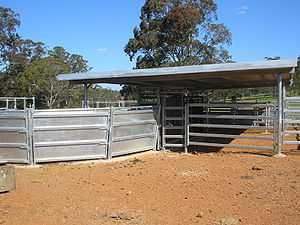Cattle race

A cattle race (Australia, British Isles and New Zealand) also called a cattle chute or run or alley (North America)[1][2] is a narrow corridor built for cattle, sheep, pigs and other animals to travel through when being herded from one location to another that is nearby. A conventional race consists of parallel panels or fences with a space between them just wide enough for one animal to pass through comfortably without being able to turn around, thus forming the animals into a queue that only allows them to go forward.[3] It is used for routine husbandry activities such as drafting (sorting) or loading animals via ramp or loading chute into a vehicle; placing them one at a time in a cattle crush (variations also called a squeeze chute or standing stock) for examination, marking or veterinary treatment. They are also used at packing plants to move animals into a crush designed for slaughter.
Overview
An experimental humane design of cattle run, by Temple Grandin, gradually narrows so that cattle have ample time to form the queue, and curves to encourage cattle to move forward in a controlled manner (see photo).
Calves (and other smaller animals such as sheep) can turn around in an adult cattle race, so a narrower race is required for proper handling. Thus the width of some races are adjustable to accommodate different sized animals.
Cattle races may be portable, or may be a permanent fixture with a concrete walkway. Portable races may be made of steel, iron or aluminium; but modern permanent ones are usually of steel or iron (sometimes timber or even concrete) which is usually set in concrete, with solid or railed sides and a non-slip floor. Anti-bruise races do not have sharp edges, and instead use pipe with rounded edges such as oval rails; alternatively sides with sheet iron or steel can be found or built onto the races, which improves livestock movement and also prevents injuries from animals getting their legs or heads caught between the rails. Races that have concrete floors have the flooring made wider than the race itself to prevent hooves catching between the bottom rail and the edge of the concrete. The concrete is also not smooth like that on city sidewalks but roughed out to give the animals more traction to prevent slipping and injury. Lower parts of the race have side panels that may be removable in the event of an animal becoming cast (fallen) or caught up in which the animal is needed to be freed to prevent further injury.
The length of the race is usually determined by the size of the herd – a longer one requires less penning-up of a larger herd. Longer races may be curved, to improve the movement of the animals. However races longer than 24 feet (7.3 m) tend to cause trouble with the flow of the animals into the loading chute or cattle crush. A walkway may be provided on the outside of the race, on one or both sides, to allow handlers easier handling, examination or treatment of animals from above.
There are gates at the start and end of the race to regulate the movement of animals. The entrance is from a small funnel-shaped or semi-circular forcing pen (or forcing yard or crowding tub), where a gate is used to move cattle into the race. The gates are usually arranged so the operator cannot become trapped or injured by the cattle. This is achieved in several ways:
- using a sliding gate operated from outside the race, commonly found between the exit of the crowding tub and the entrance to the race, in the middle of the race itself, or at the end of the race in entrance to the crush or loading chute;
- unlatching exit gates by a remotely operated cord;
- or for a forcing pen gate which uses a self-locking brake-latch that will lock if animals move back on it but be pushed forward by the handler. A latch is pulled back to unlock the gate so that it can open to another batch of livestock waiting to be forced in behind the previous batch. This forcing pen gate can swing at an angle of 180° to 300°.
|
A calf race leading to a calf cradle |
The exit from the race may be through a drafting gate (or shedding gate), which swings to open one or another of several exits for separating animals into various groups.
Calf race/cradle
A calf race and cradle makes calf branding and castration much quicker and cleaner. The calf is forced into a crush, like that of a normal crush, except it is pushed to one side and held by steel bars as shown in the photo on the right. Note that the bars are nowhere near the belly region of the calf, only located on the neck and in front of the stifle. Then one side of the crush is tipped 90°, exposing the side of the calf to be branded or examined. Calf cradles are available in temporary or permanent styles like that described above. The steel transportable race and table cradle, as shown in the photo, are very popular in Australia and New Zealand, but are also found in North America.
References
- ↑ "Cattle handling equipment", bowmanenterprisesnet.com
- ↑ "SWEEPS & ALLEYS", filsonlivestockequip.com.
- ↑ Doyle, Philip W., Beef Cattle Yards, NSW Dept. of Agriculture, 1979.
External links
- Beef cattle yards for less than 100 head (5th ed), New South Wales Department of Agriculture, 2003
- Circular cattle yard - 250 head capacity (2nd ed), New South Wales Department of Agriculture, 1999
- Cattle Handling Facilities: Department of Agriculture and Environmental Affairs KwaZulu-Natal
- Beef cattle yards: Queensland Government Department of Primary Industries and Fisheries